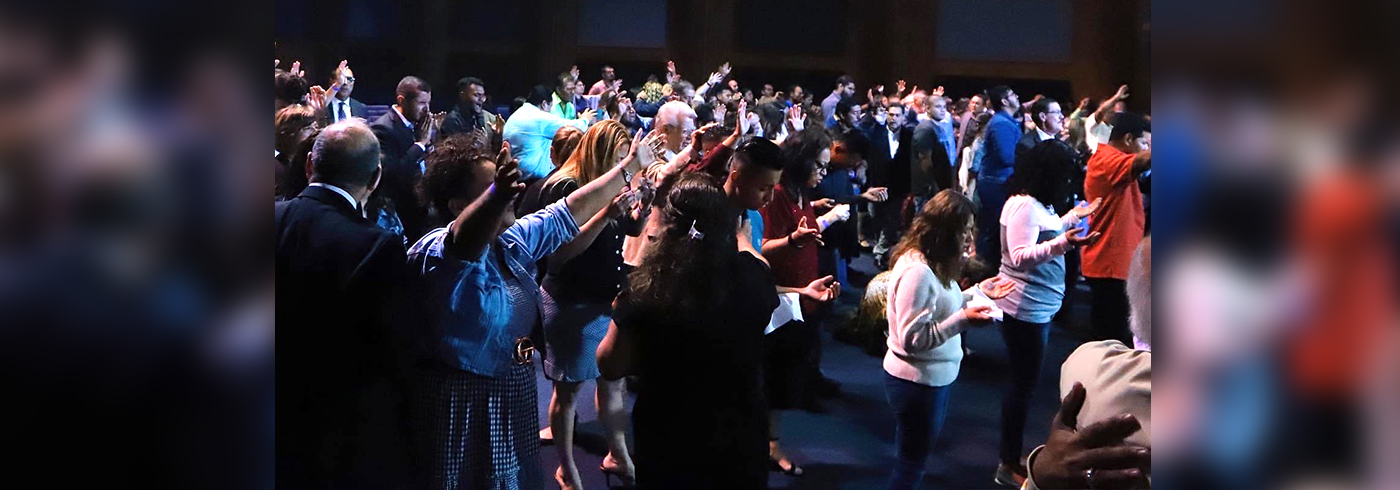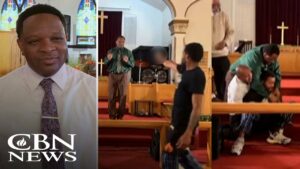U.S. Hispanic Church Survey Confirms Beliefs, Reveals Surprises
 A large survey conducted this past fall of U.S. Hispanic churches and networks included encouraging results from the Assemblies of God.
A large survey conducted this past fall of U.S. Hispanic churches and networks included encouraging results from the Assemblies of God.
The Assemblies of God took part in a Lifeway Research Hispanic Church survey as a part of what is believed to be one of the largest surveys of Protestant Hispanic congregations invited to participate in a single research study as two dozen denominations and church networks participated.
Recently, the overall findings were released, revealing that Hispanic churches are a young and growing church community that has great promise for future growth. In addition, the statistics for the Assemblies of God responses were pulled separately — some of which compared favorably with the overall Protestant results, and some that differed significantly.
“The Assemblies of God is viewed as a leader among Hispanic Protestant churches in the U.S.,” says Dennis Rivera, director of the Office of Hispanic and Ethnic Relations for the AG. “We have nearly 3,000 churches and have been involved in U.S. Hispanic ministry far longer than most Protestant denominations.”
MATCHES
There are many similarities between the survey results found overall as compared to the results of the AG Hispanic churches that responded.
In the AG, 38% of Hispanic congregants were under the age of 30 and an additional 37% were between the ages of 30 to 49. Overall, the numbers were 34% and 38%, respectively. Both sets of data indicate the Hispanic church in the U.S. is relatively young — in other words, not aging out.
“We’re young and vibrant,” confirms Rivera. “In fact, I believe that the Hispanic church, especially in the Assemblies of God, is growing far faster than official numbers indicate. I’ve wondered if the next Great Awakening hasn’t already begun only we’re not as aware because it’s happening in the Hispanic and other ethnic immigrant churches and communities.”
What some may see as surprising is that nearly half of the AG Hispanic ministers participating in the survey were born outside of the United States and 37% have graduate degrees and another 31% have bachelor’s degrees.
“What we’re finding is that more and more Hispanic pastors, as their church matures, are looking to advance their education, oftentimes because the young people in the church have advanced education,” Rivera says. “I’ve been in communication with AG Theological Seminary, and they have confirmed that there has been an overwhelming response by Hispanic ministers to their new ministerial advancement courses.”
The Hispanic Church, despite efforts to reach out to and welcome other ethnicities and cultures, remains solidly Hispanic. In the AG, 93% of the congregation are Hispanic, with 51% of members originating from Mexico. This compares closely to overall findings of 94% Hispanic and 46% from Mexico. The Caribbean was second with 22% in both AG and overall statistics.
Possibly not a surprise, but more of a confirmation, was that long work hours (57%) and family gatherings (birthdays, celebrations, etc.) (45%) were the top two reasons in the AG (and overall, 61% and 35%, respectively) that kept adults from participating more regularly in activities of the church.
“Family is generally a priority among Hispanics,” Rivera says, “and relationships are far more important than schedules, which can then conflict somewhat with church activities as those activities need to be on some kind of a schedule.”
Rivera also noted that the long work hours should not be overlooked. As many Hispanics work in the hotel, restaurant, and other service industries, he’s found that church services held on Sunday afternoons or evenings are not uncommon because working weekend morning hours or late Saturday night hours are often mandatory.
And although congregations are by vast majority Hispanic (more than nine out of 10), 91% of AG responding pastors and 88% pastors overall have heard their congregations being welcoming to those from different cultures and backgrounds, which would seem to indicate those of different cultures and backgrounds are intentionally sought out and welcomed.
DIFFERENCES
Some may be surprised to see that 43% of responding AG Hispanic pastors are first generation immigrant pastors, whereas overall that number is 66%. Within the AG, however, 34% of the responding ministers were born in the United States while their parents were born outside of the United States; overall that number is 15%.
“These figures seem to indicate that AG churches are more established, as now we’re seeing that first U.S.-born generation maturing and taking leadership roles,” explains Rivera.
Other statistics point to the longevity of AG Hispanic ministry. Just 35% of the AG churches responding were established after 2000, whereas 54% were established after 2000 overall.
AG churches also appear to have higher attendance overall, which could be tied into longevity — only 17% of AG Hispanic churches responding had 0 to 49 congregants, while that represented 29% overall. Meanwhile, 29% had 250 congregants or more in the AG, with only 9% registering that number overall.
AG Hispanic churches also seemed to place a greater emphasis on children’s church as it was offered in 71% of the responding churches compared to 47% overall. And children’s church was viewed as one of the top-two children’s activities for fostering meaningful spiritual growth by 50% of AG respondents, while 42% also chose VBS. Overall, the comparison number for children’s church was significantly less (34%) while the VBS number was roughly the same (39%).
The AG responders also saw certain activities for youth noticeably stronger in several areas over the past year. Doing local or regional events with other churches 58% for AG, 37% overall; having youth praise and worship nights, 49% to 32%; and taking part in recreational activity trips, 42% to 27%.
“I believe these numbers again speak to the maturity and establishment of these responding Hispanic AG churches,” Rivera says. “It also speaks to the fact that these churches understand the future of the church is the coming generations -- it’s vital that we integrate them into ministry and invest in them by providing opportunities for mentoring and developing those relationships.”
WHAT’S AHEAD
In the media, it’s frequently mentioned how many mainline churches are dying because their congregations are aging out — many with a majority of members 60 and older. However, that’s far from the case for Hispanic Protestant churches according to this study.
As noted earlier, AG responders stated that an amazing 38% of congregants are under the age of 30 and 75% are under the age of 50. The numbers are similar in the overall responses.
“We have a young, growing, Spirit-filled Hispanic AG church that God has been quietly nurturing and blessing for decades,” Rivera says. “I believe we’re now seeing signs of that church maturing and preparing to explode in growth and influence as this next generation of Hispanic young people are empowered to take the gospel to the world.”
To review all the questions and the overall results of the Lifeway Research survey, click here.
Recently, the overall findings were released, revealing that Hispanic churches are a young and growing church community that has great promise for future growth. In addition, the statistics for the Assemblies of God responses were pulled separately — some of which compared favorably with the overall Protestant results, and some that differed significantly.
“The Assemblies of God is viewed as a leader among Hispanic Protestant churches in the U.S.,” says Dennis Rivera, director of the Office of Hispanic and Ethnic Relations for the AG. “We have nearly 3,000 churches and have been involved in U.S. Hispanic ministry far longer than most Protestant denominations.”
MATCHES
There are many similarities between the survey results found overall as compared to the results of the AG Hispanic churches that responded.
In the AG, 38% of Hispanic congregants were under the age of 30 and an additional 37% were between the ages of 30 to 49. Overall, the numbers were 34% and 38%, respectively. Both sets of data indicate the Hispanic church in the U.S. is relatively young — in other words, not aging out.
“We’re young and vibrant,” confirms Rivera. “In fact, I believe that the Hispanic church, especially in the Assemblies of God, is growing far faster than official numbers indicate. I’ve wondered if the next Great Awakening hasn’t already begun only we’re not as aware because it’s happening in the Hispanic and other ethnic immigrant churches and communities.”
What some may see as surprising is that nearly half of the AG Hispanic ministers participating in the survey were born outside of the United States and 37% have graduate degrees and another 31% have bachelor’s degrees.
“What we’re finding is that more and more Hispanic pastors, as their church matures, are looking to advance their education, oftentimes because the young people in the church have advanced education,” Rivera says. “I’ve been in communication with AG Theological Seminary, and they have confirmed that there has been an overwhelming response by Hispanic ministers to their new ministerial advancement courses.”
The Hispanic Church, despite efforts to reach out to and welcome other ethnicities and cultures, remains solidly Hispanic. In the AG, 93% of the congregation are Hispanic, with 51% of members originating from Mexico. This compares closely to overall findings of 94% Hispanic and 46% from Mexico. The Caribbean was second with 22% in both AG and overall statistics.
Possibly not a surprise, but more of a confirmation, was that long work hours (57%) and family gatherings (birthdays, celebrations, etc.) (45%) were the top two reasons in the AG (and overall, 61% and 35%, respectively) that kept adults from participating more regularly in activities of the church.
“Family is generally a priority among Hispanics,” Rivera says, “and relationships are far more important than schedules, which can then conflict somewhat with church activities as those activities need to be on some kind of a schedule.”
Rivera also noted that the long work hours should not be overlooked. As many Hispanics work in the hotel, restaurant, and other service industries, he’s found that church services held on Sunday afternoons or evenings are not uncommon because working weekend morning hours or late Saturday night hours are often mandatory.
And although congregations are by vast majority Hispanic (more than nine out of 10), 91% of AG responding pastors and 88% pastors overall have heard their congregations being welcoming to those from different cultures and backgrounds, which would seem to indicate those of different cultures and backgrounds are intentionally sought out and welcomed.
DIFFERENCES
Some may be surprised to see that 43% of responding AG Hispanic pastors are first generation immigrant pastors, whereas overall that number is 66%. Within the AG, however, 34% of the responding ministers were born in the United States while their parents were born outside of the United States; overall that number is 15%.
“These figures seem to indicate that AG churches are more established, as now we’re seeing that first U.S.-born generation maturing and taking leadership roles,” explains Rivera.
Other statistics point to the longevity of AG Hispanic ministry. Just 35% of the AG churches responding were established after 2000, whereas 54% were established after 2000 overall.
AG churches also appear to have higher attendance overall, which could be tied into longevity — only 17% of AG Hispanic churches responding had 0 to 49 congregants, while that represented 29% overall. Meanwhile, 29% had 250 congregants or more in the AG, with only 9% registering that number overall.
AG Hispanic churches also seemed to place a greater emphasis on children’s church as it was offered in 71% of the responding churches compared to 47% overall. And children’s church was viewed as one of the top-two children’s activities for fostering meaningful spiritual growth by 50% of AG respondents, while 42% also chose VBS. Overall, the comparison number for children’s church was significantly less (34%) while the VBS number was roughly the same (39%).
The AG responders also saw certain activities for youth noticeably stronger in several areas over the past year. Doing local or regional events with other churches 58% for AG, 37% overall; having youth praise and worship nights, 49% to 32%; and taking part in recreational activity trips, 42% to 27%.
“I believe these numbers again speak to the maturity and establishment of these responding Hispanic AG churches,” Rivera says. “It also speaks to the fact that these churches understand the future of the church is the coming generations -- it’s vital that we integrate them into ministry and invest in them by providing opportunities for mentoring and developing those relationships.”
WHAT’S AHEAD
In the media, it’s frequently mentioned how many mainline churches are dying because their congregations are aging out — many with a majority of members 60 and older. However, that’s far from the case for Hispanic Protestant churches according to this study.
As noted earlier, AG responders stated that an amazing 38% of congregants are under the age of 30 and 75% are under the age of 50. The numbers are similar in the overall responses.
“We have a young, growing, Spirit-filled Hispanic AG church that God has been quietly nurturing and blessing for decades,” Rivera says. “I believe we’re now seeing signs of that church maturing and preparing to explode in growth and influence as this next generation of Hispanic young people are empowered to take the gospel to the world.”
To review all the questions and the overall results of the Lifeway Research survey, click here.




